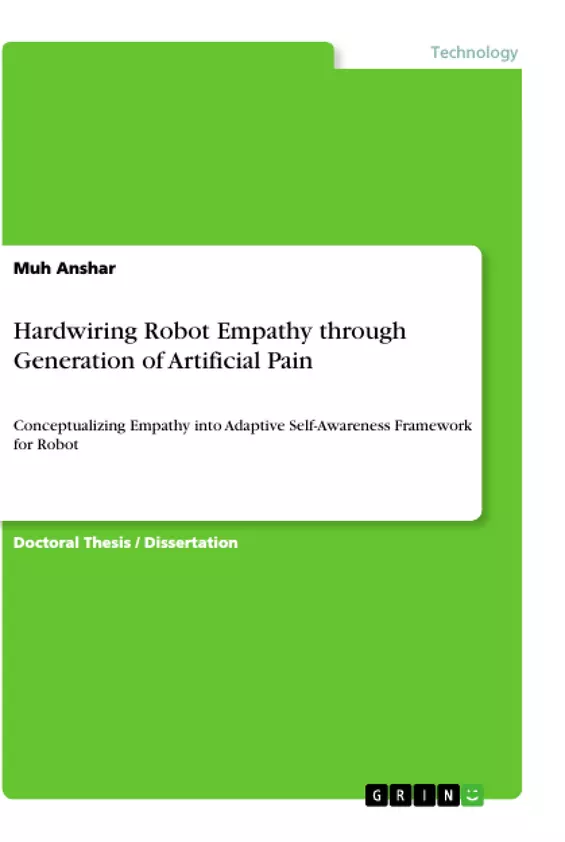The application and use of robots in various areas of human life have been growing since the advent of robotics, and as a result, an increasing number of collaboration tasks are taking place. During a collaboration, humans and robots typically interact through a physical medium and it is likely that as more interactions occur, the possibility for humans to experience pain will increase. It is therefore of primary importance that robots should be capable of understanding the human concept of pain and to react to that understanding. However, studies reveal that the concept of human pain is strongly related to the complex structure of the human nervous system and the concept of Mind which includes concepts of Self-Awareness and Consciousness. Thus, developing an appropriate concept of pain for robots must incorporate the concepts of Self-Awareness and Consciousness. Our approach is firstly to acquire an appropriate concept of self-awareness as the basis for a robot framework. Secondly, it is to develop an internal capability for a framework for the internal state of the mechanism by inferring information captured through internal and external perceptions. Thirdly, to conceptualise an artificially created pain classification in the form of synthetic pain which mimics the human concept of pain. Fourthly, to demonstrate the implementation of synthetic pain activation on top of the robot framework, using a reasoning approach in relation to past, current and future predicted conditions. Lastly, our aim is to develop and demonstrate an empathy function as a counter action to the kinds of synthetic pain being generated. The framework allows robots to develop "self-consciousness" by focusing attention on two primary levels of self, namely subjective and objective. Once implemented, we report the results and provide insights from novel experiments designed to measure whether a robot is capable of shifting its "self-consciousness" using information obtained from exteroceptive and proprioceptive sensory perceptions. We consider whether the framework can support reasoning skills that allow the robot to predict and generate an accurate "pain" acknowledgement, and at the same time, develop appropriate counter responses. Our experiments are designed to evaluate synthetic pain classification, and the results show that the robot is aware of its internal state through the ability to predict its joint motion and produce appropriate artificial pain generation.
Inhaltsverzeichnis (Table of Contents)
- Abstract
- Acknowledgements
- Introduction
- Motivation
- Contribution
- Outline
- Literature Review
- Pain and Empathy in Human
- Pain and Empathy in Robot
- Social Cognitive Robotics (SCR)
- System Design and Implementation
- Sensor for Pain Sensing
- Artificial Pain Generator
- Emotion Mapping
- Pain Expression Controller
- Experimental Results
- Pain Sensing Results
- Pain Expression Results
- Discussion
- Limitations
- Further Research Directions
- Conclusions
- References
Zielsetzung und Themenschwerpunkte (Objectives and Key Themes)
This book presents research on the development and implementation of an artificial pain system for robots, aiming to facilitate the understanding of pain perception and empathy in artificial agents. It explores the potential of using pain generation as a mechanism to enhance robots' ability to understand and respond to human emotions.
- Developing a system for generating artificial pain in robots.
- Exploring the potential of pain generation to foster empathy in robots.
- Investigating the role of pain perception and expression in human-robot interaction.
- Examining the ethical implications of implementing pain in artificial agents.
- Exploring the potential applications of pain-sensitive robots in various domains.
Zusammenfassung der Kapitel (Chapter Summaries)
The book begins by introducing the motivation and contributions of the research, highlighting the significance of developing empathetic robots. Chapter 2 provides a comprehensive literature review on pain and empathy in both humans and robots, laying the groundwork for the proposed system. Chapter 3 delves into the design and implementation of the artificial pain system, outlining the different components involved, such as pain sensors, artificial pain generators, and emotion mapping mechanisms. Chapter 4 presents the experimental results obtained from the implementation of the system, showcasing the robot's ability to perceive and express pain. Chapter 5 discusses the limitations of the study and outlines potential future research directions.
Schlüsselwörter (Keywords)
The research focuses on the keywords "artificial pain", "robot empathy", "social cognitive robotics", "pain sensing", "pain expression", "human-robot interaction", "ethical implications", and "future directions". These concepts are explored through the development and implementation of a system that generates artificial pain in robots, aiming to enhance their understanding of human emotions and facilitate more natural interactions.
- Quote paper
- Muh Anshar (Author), 2017, Hardwiring Robot Empathy through Generation of Artificial Pain, Munich, GRIN Verlag, https://www.grin.com/document/498980



